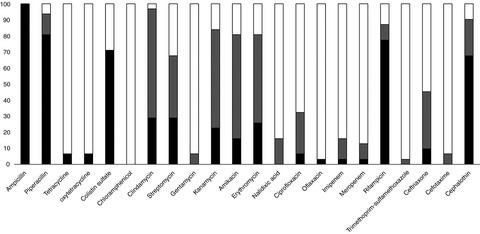当前位置:
X-MOL 学术
›
Lett. Appl. Microbiol.
›
论文详情
Our official English website, www.x-mol.net, welcomes your feedback! (Note: you will need to create a separate account there.)
Manila clam ( Ruditapes philippinarum ) marketed in Korea as a source of vibrios harboring virulence and β‐lactam resistance genes
Letters in Applied Microbiology ( IF 2.4 ) Pub Date : 2019-11-04 , DOI: 10.1111/lam.13229 P S Dahanayake 1 , S Hossain 1 , M V K S Wickramanayake 1 , S H M P Wimalasena 2 , G-J Heo 1
Letters in Applied Microbiology ( IF 2.4 ) Pub Date : 2019-11-04 , DOI: 10.1111/lam.13229 P S Dahanayake 1 , S Hossain 1 , M V K S Wickramanayake 1 , S H M P Wimalasena 2 , G-J Heo 1
Affiliation

|
The present study assessed the occurrence, virulence determinants and antimicrobial susceptibility patterns of Vibrio spp. isolated from live Manila clam (Ruditapes philippinarum). A total of 31 Vibrio spp. including 27 V. diabolicus, two V. fluvialis, one V. alginolyticus and one V. antiquarius were isolated and identified. Phenotypic detection of DNase, lipase, phospholipase, amylase and caseinase activities was 100%; and 87% gelatinase, 45% slime production and 6% haemolysin activities were also observed. The prevalence of toxin‐related virulence genes for collagenase (94%), toxR (100%), tlh (68%), and VPI (71%) was detected by PCR. Additionally, two V. fluvialis isolates carried F‐toxR and hupo genes. Moreover, 61% of the isolates showed multiple antimicrobial resistance indices >0·2. The resistance rates of ampicillin, piperacillin, colistin sulfate, rifampicin, and cephalothin were 100, 81, 71, 77 and 68% respectively. The prevalence of blaCTX‐M (87%), blaTEM (55%) and Int1 (90%) genes was observed, whereas blaSHV, strA‐strB, tetA, tetB, and aadA2 gene cassette were reported in varying combinations. However, armA, aac(3)‐IIa and quinolone resistance genes (qnrA, qnrB, qnrS) were not amplified. Thus, the virulence along with extended‐spectrum β‐lactamases (ESBLs) and other antimicrobial resistance genes in multidrug‐resistant Manila clam‐borne vibrios may pose a public health threat for consumers.
中文翻译:

在韩国销售的马尼拉蛤(菲律宾蛤蜊)是一种含有毒力和β-内酰胺抗性基因的弧菌来源
本研究评估了弧菌属的发生、毒力决定因素和抗菌药物敏感性模式。从活的马尼拉蛤 (Ruditapes philippinarum) 中分离出来。共 31 个弧菌属。包括27 V. diabolicus、2 V.fluvialis、1 V. alginolyticus和1 V. antiquarius被分离和鉴定。DNase、脂肪酶、磷脂酶、淀粉酶和酪蛋白酶活性的表型检测为100%;还观察到 87% 的明胶酶、45% 的粘液产生和 6% 的溶血素活性。通过 PCR 检测胶原酶 (94%)、toxR (100%)、tlh (68%) 和 VPI (71%) 的毒素相关毒力基因的流行。此外,两个 V.fluvialis 分离株携带 F-toxR 和 hupo 基因。此外,61% 的分离株表现出多重抗菌素耐药性指数 >0·2。氨苄青霉素、哌拉西林、硫酸粘菌素、利福平和头孢菌素分别为 100、81、71、77 和 68%。观察到 blaCTX-M (87%)、blaTEM (55%) 和 Int1 (90%) 基因的流行,而 blaSHV、strA-strB、tetA、tetB 和 aadA2 基因盒以不同的组合被报道。然而,armA、aac(3)-IIa 和喹诺酮类抗性基因(qnrA、qnrB、qnrS)未扩增。因此,多药耐药马尼拉蛤蜊传播弧菌中的毒性以及超广谱β-内酰胺酶(ESBLs)和其他抗菌素耐药基因可能对消费者构成公共卫生威胁。aac(3)-IIa 和喹诺酮类抗性基因(qnrA、qnrB、qnrS)未扩增。因此,多药耐药马尼拉蛤蜊传播弧菌中的毒性以及超广谱β-内酰胺酶(ESBLs)和其他抗菌素耐药基因可能对消费者构成公共卫生威胁。aac(3)-IIa 和喹诺酮类抗性基因(qnrA、qnrB、qnrS)未扩增。因此,多药耐药马尼拉蛤蜊传播弧菌中的毒性以及超广谱β-内酰胺酶(ESBLs)和其他抗菌素耐药基因可能对消费者构成公共卫生威胁。
更新日期:2019-11-04
中文翻译:

在韩国销售的马尼拉蛤(菲律宾蛤蜊)是一种含有毒力和β-内酰胺抗性基因的弧菌来源
本研究评估了弧菌属的发生、毒力决定因素和抗菌药物敏感性模式。从活的马尼拉蛤 (Ruditapes philippinarum) 中分离出来。共 31 个弧菌属。包括27 V. diabolicus、2 V.fluvialis、1 V. alginolyticus和1 V. antiquarius被分离和鉴定。DNase、脂肪酶、磷脂酶、淀粉酶和酪蛋白酶活性的表型检测为100%;还观察到 87% 的明胶酶、45% 的粘液产生和 6% 的溶血素活性。通过 PCR 检测胶原酶 (94%)、toxR (100%)、tlh (68%) 和 VPI (71%) 的毒素相关毒力基因的流行。此外,两个 V.fluvialis 分离株携带 F-toxR 和 hupo 基因。此外,61% 的分离株表现出多重抗菌素耐药性指数 >0·2。氨苄青霉素、哌拉西林、硫酸粘菌素、利福平和头孢菌素分别为 100、81、71、77 和 68%。观察到 blaCTX-M (87%)、blaTEM (55%) 和 Int1 (90%) 基因的流行,而 blaSHV、strA-strB、tetA、tetB 和 aadA2 基因盒以不同的组合被报道。然而,armA、aac(3)-IIa 和喹诺酮类抗性基因(qnrA、qnrB、qnrS)未扩增。因此,多药耐药马尼拉蛤蜊传播弧菌中的毒性以及超广谱β-内酰胺酶(ESBLs)和其他抗菌素耐药基因可能对消费者构成公共卫生威胁。aac(3)-IIa 和喹诺酮类抗性基因(qnrA、qnrB、qnrS)未扩增。因此,多药耐药马尼拉蛤蜊传播弧菌中的毒性以及超广谱β-内酰胺酶(ESBLs)和其他抗菌素耐药基因可能对消费者构成公共卫生威胁。aac(3)-IIa 和喹诺酮类抗性基因(qnrA、qnrB、qnrS)未扩增。因此,多药耐药马尼拉蛤蜊传播弧菌中的毒性以及超广谱β-内酰胺酶(ESBLs)和其他抗菌素耐药基因可能对消费者构成公共卫生威胁。


























 京公网安备 11010802027423号
京公网安备 11010802027423号